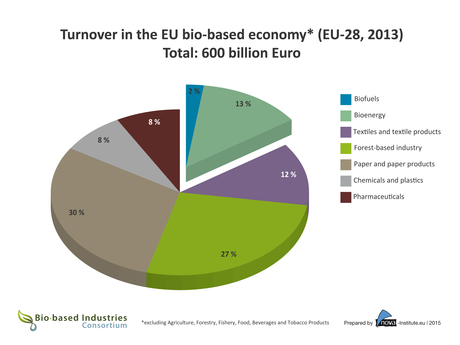The European bioeconomy under the microscope

Comprehensive data on the European bioeconomy — that is, those parts of the economy that use renewable biological resources from land and sea to produce food, materials and energy — has been released for the first time. Generated by nova-Institute on behalf of the Bio-based Industries Consortium (BIC), the data shows which macroeconomic effects are generated by bioeconomic activities.
The data shows that the turnover of the total bioeconomy, including food and beverages and the primary sectors agriculture and forestry, resulted in €2.1 trillion in the EU-28 in 2013. Roughly half of the turnover is accounted for by the food and beverages sector, while almost a quarter is created by the primary sectors, agriculture and forestry. The other quarter is created by the bio-based industries, such as chemicals and plastics, pharmaceuticals, paper and paper products, forest-based industries, textile sector, biofuels and bioenergy.
The bioeconomy employs 18.3 million people in total. The primary biomass production, mainly agriculture plus forestry and fishery, generates a lot of employment (58%) but low turnover (21%). The Eastern European countries Poland, Romania and Bulgaria are apparently stronger in less value-added sectors of the bio-based economy that generate a lot of employment. In comparison, Western and Northern European countries generate much higher turnover compared to the employment generated. The countries with the highest ratio between turnover and employment are Ireland, Finland and Belgium.
“Of particular interest are the often underrated bio-based industries, such as chemicals and plastics, pharmaceuticals, paper and paper products, forest-based industries, textile sector, biofuels and bioenergy,” said Michael Carus, managing director of nova-Institute. “This sector shows considerable turnover of €600 billion and 3.2 million employees in 2013 for EU-28.”
The data shows a slight increase in the bio-based share of the chemical industry in the EU-28 from 5% in 2008 to 6% in 2013. The raw materials used by the chemical industry are about 50% organic (fossil and bio-based) and about 50% inorganic (minerals, metals).
Only taking the organic part into account, the overall bio-based share increased from 10% in 2008 to 12% in 2013. Denmark had the highest bio-based share in the chemical industry in 2013, which is mainly due to the high production of enzymes. Latvia and Sweden follow primarily due to a large production volume of charcoal and tall oil.
According to a 2014 survey, BIC members intended to invest €1.1 billion during 2014 to 2015 in bio-based industries — mainly demo and flagship projects, of which more than €820 million were pure private investment. Private investments in the amount of more than €2.1 billion are in the pipelines of those same BIC members for the time between 2014 and 2020. Most of the short-term investments will take place in the lignocellulosic and forestry-based value chains.
The full report can be downloaded at www.bio-based.eu/markets and will be updated annually.
Liquid catalyst could transform chemical manufacturing
A major breakthrough in liquid catalysis is transforming how essential products are made, making...
How light helps plants survive in harsh environments
Researchers from National Taiwan University have uncovered how light stabilises a key...
SKA-Low's first image of the universe released
The image is an indication of the scientific revelations that will be possible with the...




